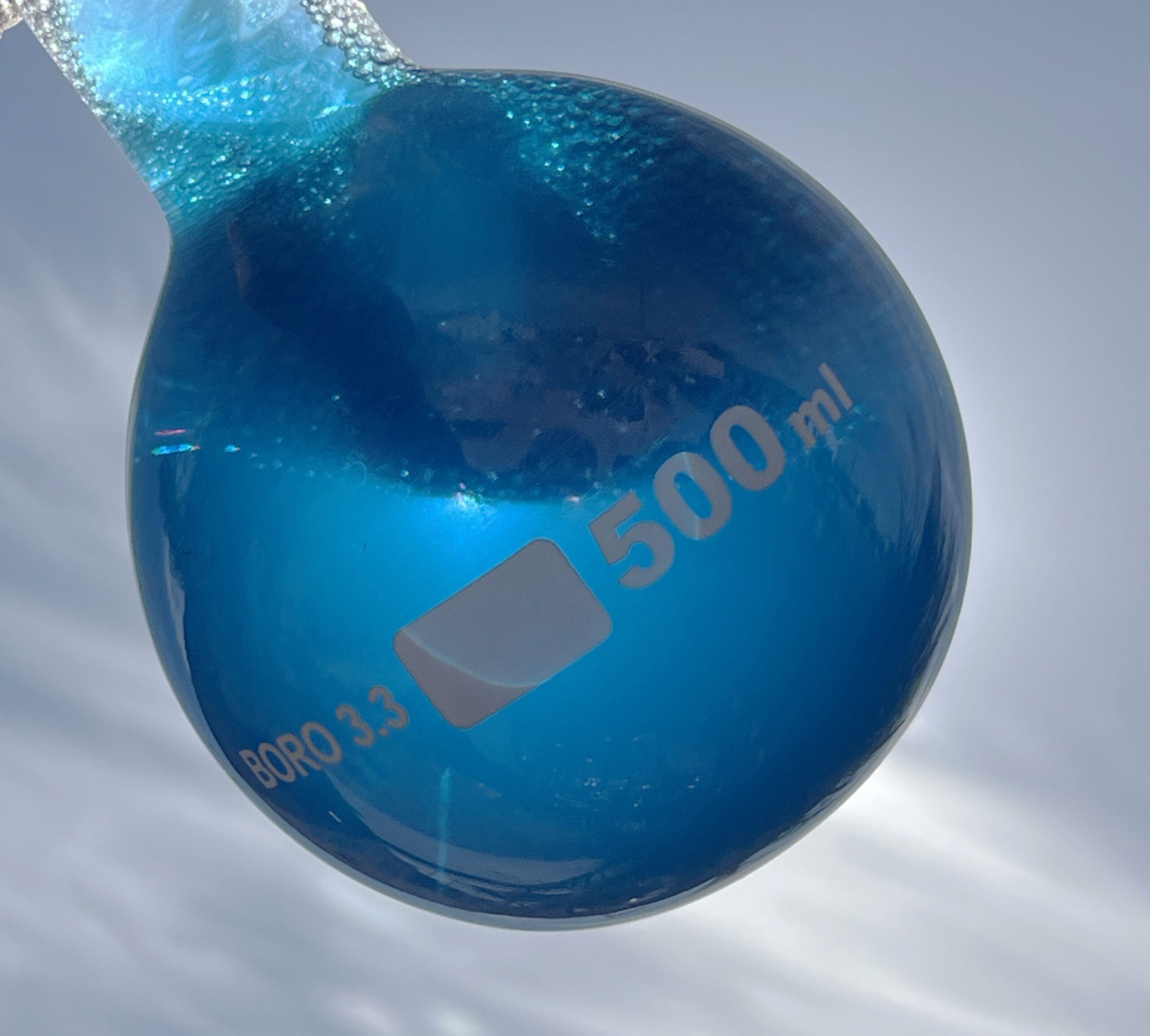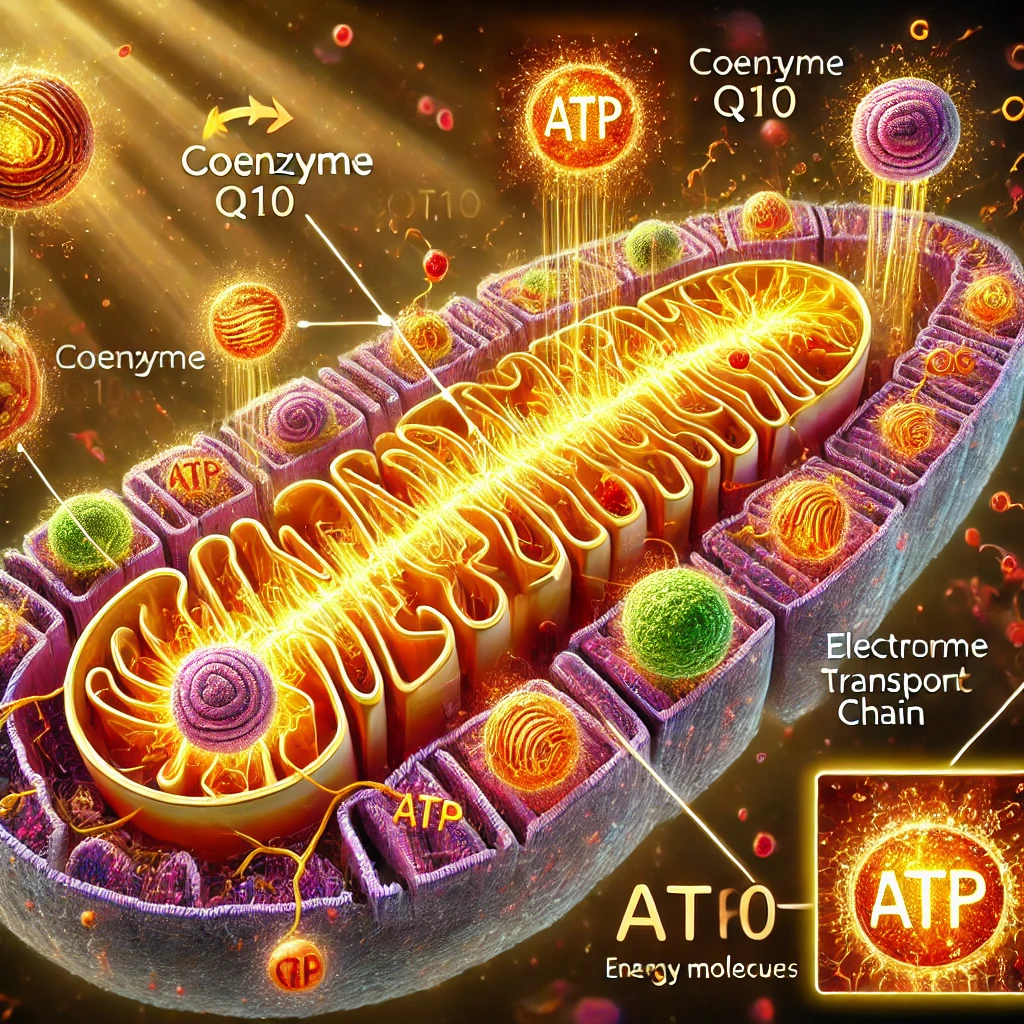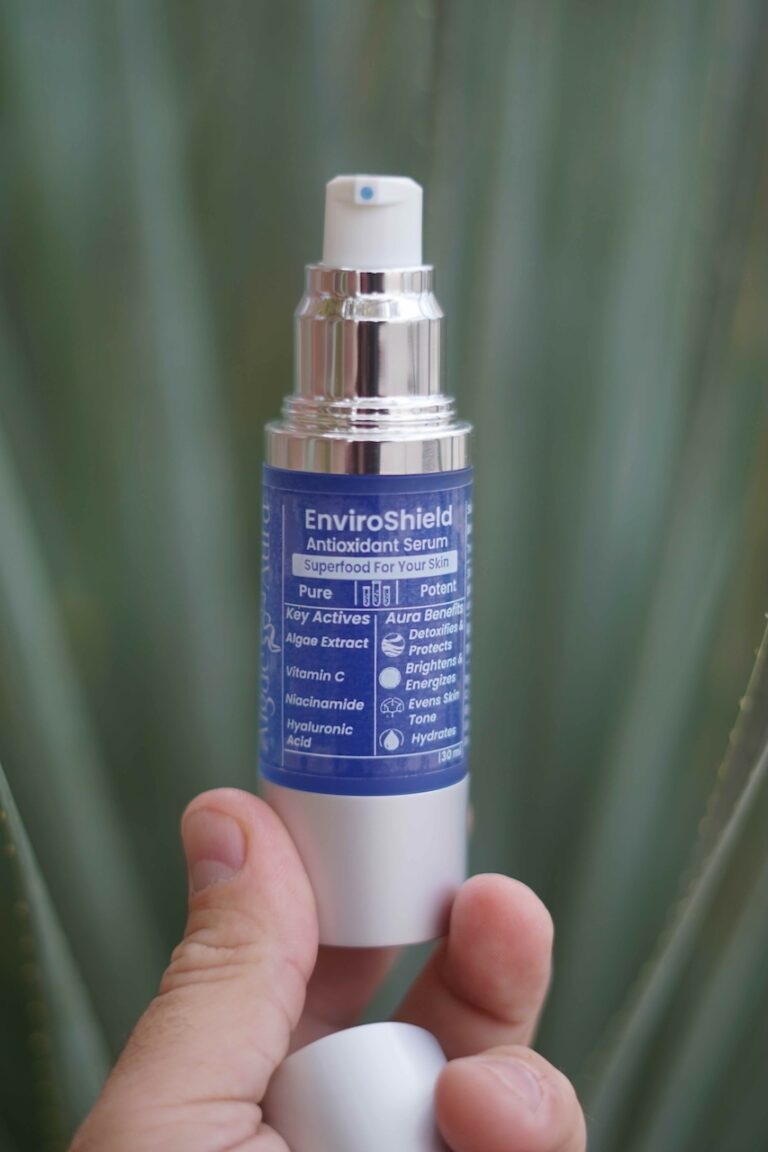Introduction
Blue-hued natural skincare ingredients are having a major moment. From sapphire-toned face oils to indigo-infused creams, these vivid botanical extracts are captivating consumers and lighting up social media feeds. Part of the appeal is visual – a jar of deep blue balm looks as soothing as it feels – but there’s more driving this trend than Instagrammable color. In the clean beauty movement, where plant-derived, non-toxic ingredients reign, blue botanicals have surged in popularity for their calming and anti-inflammatory benefits. Shoppers are drawn to skincare that not only is natural but also looks natural, and the color blue has come to symbolize potent remedies sourced from flowers, herbs, and even algae vitacost.com.
One standout in this blue ingredient boom is phycocyanin, a unique compound derived from Spirulina algae. Unlike some trendy ingredients that rely on folklore, phycocyanin boasts strong scientific backing. This brilliant aqua pigment is actually a protein complex found in blue-green algae, prized for its powerful antioxidant and anti-inflammatory properties pmc.ncbi.nlm.nih.gov. As we’ll explore, phycocyanin offers a high-tech twist on the “blue beauty” craze – delivering serious skin benefits while aligning with the clean, nature-powered ethos consumers love.
Section 1: Exploring Phycocyanin
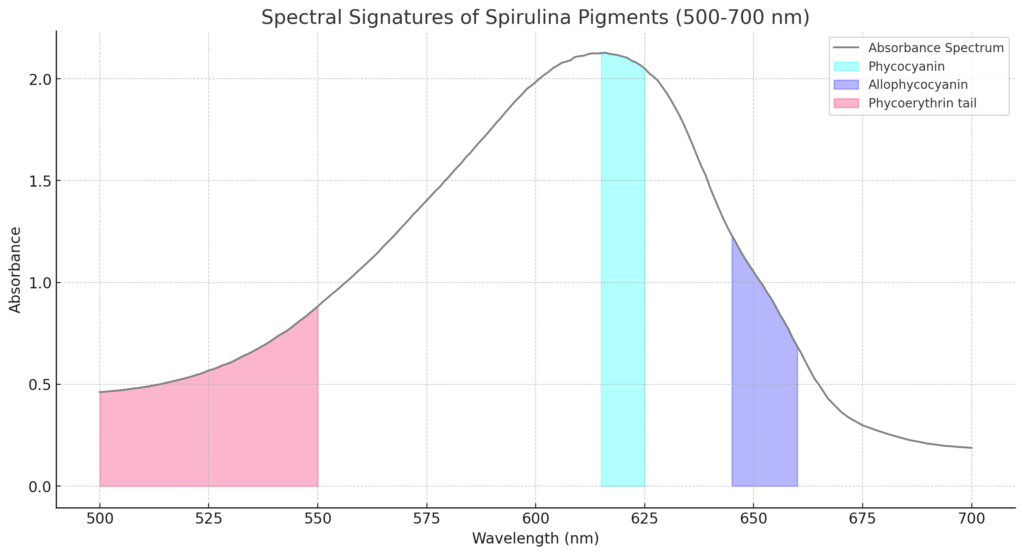
What is phycocyanin? In simple terms, it’s the blue pigment that gives Spirulina (a type of cyanobacteria often called blue-green algae) its vibrant teal color. Chemically, phycocyanin is a phycobiliprotein – a protein bound to light-capturing pigments – that allows algae to absorb sunlight for energy. In skincare terms, phycocyanin is a multi-talented active ingredient: a water-soluble, non-toxic compound that brings both a striking natural blue hue and a suite of benefits. Extracted from Spirulina platensis, it’s already used in foods and cosmetics as a natural colorant and antioxidant booster pmc.ncbi.nlm.nih.gov. In fact, phycocyanin is so safe it’s one of the only natural blue colorants approved for use in foods by regulators, reflecting its low toxicity and biocompatibility.
Extraction and purity: To harness phycocyanin for skincare, it must be carefully extracted from spirulina. This is where Algae Aura’s expertise comes in. The team at Algae Aura has developed proprietary extraction techniques to obtain ultra-pure, potent phycocyanin from freshly cultivated spirulina. This is no small feat – raw spirulina powder contains only about 10-15% phycocyanin, and isolating it requires breaking open the tough cell walls and stabilizing the pigment-protein, which can be sensitive to heat and light pmc.ncbi.nlm.nih.gov. Traditional methods can lead to impurities or degradation of the pigment, but Algae Aura’s advanced process (kept under wraps as a trade secret) ensures maximum potency. By using gentle, innovative extraction – free of harsh solvents and done in-house – Algae Aura is able to retain phycocyanin’s bioactivity at its peak. The result is a pure blue concentrate brimming with skin-loving nutrients, far beyond a typical spirulina extract in quality and efficacy.
Antioxidant powerhouse: One of phycocyanin’s star qualities is its antioxidant capacity. Antioxidants are crucial in skincare because they neutralize free radicals – unstable molecules from UV radiation, pollution, and stress – that can damage skin cells and accelerate aging. Phycocyanin happens to be exceptionally good at this. Studies show it scavenges a variety of free radicals and even chelates metal ions, protecting cells from oxidative stresspmc.ncbi.nlm.nih.gov. How potent is it? Remarkably, C-phycocyanin (the form in spirulina) has been found to be up to 16 times more potent than vitamin E and 20 times more potent than vitamin C in antioxidant assays researchgate.net. This means a tiny amount of this blue protein can dramatically bolster a formula’s ability to defend your skin against environmental damage. By incorporating phycocyanin, skincare products gain a powerful shield that helps keep skin firm, glowing, and youthful.
Anti-inflammatory and skin health benefits: Phycocyanin doesn’t stop at antioxidation – it’s also a natural anti-inflammatory. In algae, it plays a role in stress defense, and on our skin it can calm the signs of irritation. Research has demonstrated that phycocyanin can inhibit the release of pro-inflammatory mediators and enzymes, effectively dialing down inflammation pmc.ncbi.nlm.nih.gov – pmc.ncbi.nlm.nih.gov. For anyone with sensitive or reactive skin, this is big news: phycocyanin can help reduce redness, soothe flare-ups, and even assist in healing. There’s intriguing science emerging about its role in promoting skin repair – for example, studies have noted that spirulina extracts rich in phycocyanin accelerate wound healing and encourage cell turnover for regeneration mdpi.com. There’s also evidence that phycocyanin can interfere with pathways leading to hyperpigmentation, suggesting a potential to gently brighten the complexion mdpi.com. In short, phycocyanin is a multitasking active that protects, calms, and revitalizes the skin on a cellular level. It’s the reason Algae Aura centers its formulations on this one extraordinary algae-derived ingredient.
Section 2: Popular Blue Compounds in Skincare
Phycocyanin may be the new blue on the block, but it joins a palette of other beloved blue skincare ingredients. Here’s a look at a few trending botanical blue compounds and why they’re used in skin remedies:
- Blue Tansy: An essential oil distilled from Tanacetum annuum (Moroccan chamomile). Blue tansy oil is famed for its rich azure color, which comes from a compound called chamazulene formed during distillation vitacost.com. In skincare, blue tansy has a reputation as a skin-soother. It’s packed with anti-inflammatory and antibacterial properties, making it excellent for calming irritated or blemish-prone skin vitacost.com – 40aprons.com. A few drops of this oil can help reduce redness, quell breakouts, and ease eczema or dermatitis. Its gentle herbaceous scent and irritation-reducing effects have made blue tansy a staple in many clean beauty products aimed at sensitive skin.
- Indigo: Often appearing as “Indigo Naturalis” in ingredient lists, this deep blue plant extract has a long history in traditional Asian medicine. Derived from plants like Indigofera tinctoria or Isatis tinctoria, indigo was used in Chinese herbal remedies (called Qing Dai) for centuries to treat inflammatory skin conditions dermatology-m.com. Modern science validates this ancient wisdom: indigo is rich in indirubin and tryptanthrin, active molecules that inhibit excessive skin cell growth and inflammation. Clinical trials have shown indigo naturalis ointments can effectively improve atopic dermatitis (eczema) with regular use pubmed.ncbi.nlm.nih.gov. It’s now found in certain balms and creams (for example, high-end brands have introduced indigo-infused lotions) to soothe irritation, reduce redness, and even help conditions like psoriasis. Indigo’s anti-inflammatory and barrier-strengthening abilities make it a powerful blue ally for troubled skin.
- Other Blue Botanicals: A variety of plant-derived ingredients also bring beneficial blues to skincare. The butterfly pea flower (Clitoria ternatea), for instance, yields a gorgeous indigo-blue extract loaded with anthocyanin antioxidants. In skincare formulas, butterfly pea flower can help boost skin’s hydration and elasticity and calm redness – studies indicate it increases moisture retention and eases irritation or allergic skin responses santafe.com. Blue spirulina is another trending ingredient – essentially a common term for spirulina extract concentrated in phycocyanin. It provides a natural teal color along with antioxidant protection (thanks to phycocyanin) and is popping up in masks and serums as a plant-based superfood for the skin. Additionally, blue chamomile (German chamomile essential oil) contains the same azulene as blue tansy, imparting anti-inflammatory benefits and a soothing aroma. These botanical blue actives, from pea flowers to algae, all share the trait of imparting both a therapeutic effect and a natural tint – a reminder that sometimes the most vibrant colors in nature also signal potent healing properties.
Section 3: Phycocyanin vs. Other Blue Compounds
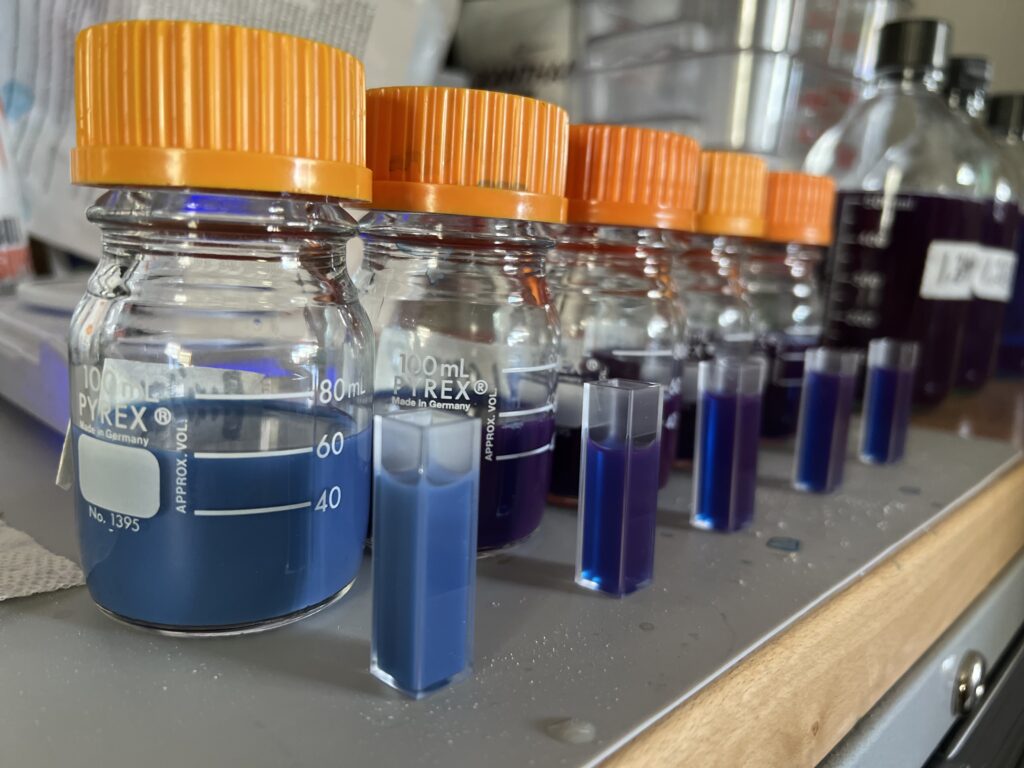
How does phycocyanin stack up against these other blue ingredients? Quite impressively – it holds its own as a skincare champion on multiple fronts:
- Antioxidant strength: Phycocyanin is arguably the heavyweight among natural blue antioxidants. Azulene (from blue tansy or chamomile) and anthocyanins (from butterfly pea) do offer antioxidant effects, but phycocyanin’s capability is on another level. As noted earlier, its radical-scavenging activity can surpass common vitamins by an order of magnitude researchgate.net. This means phycocyanin provides robust protection against environmental aging. By contrast, essential oil components like chamazulene are less studied in terms of quantifiable antioxidant potency – they work well to calm skin, but we have fewer metrics on how they guard cells from oxidative stress. Phycocyanin’s prowess is well-documented in scientific literature, giving it an edge if your goal is maximum defense against pollution, UV damage, and other free radical generators.
- Skin-soothing efficacy: All blue ingredients share a common role: they help soothe and balance irritated skin. Blue tansy can quickly take down redness from a breakout or bug bite, and indigo can calm an eczema patch in a matter of days. Phycocyanin similarly has notable anti-inflammatory effects, but with an added advantage – it’s extremely gentle. Because phycocyanin is a large water-soluble molecule (not a volatile oil), it lacks the irritating potential of some essential oils. For example, pure blue tansy oil must be properly diluted; like many essential oils, if used at full strength it can cause skin sensitization or even allergic reactions in some individuals bareluxeskincare.com. Phycocyanin, on the other hand, is used as a natural colorant in foods and has shown no toxicity or sensitization at typical concentrations pmc.ncbi.nlm.nih.gov. In practical terms, a phycocyanin-based serum can deliver calming benefits without the risk of irritation or strong fragrance. It’s odorless and non-sensitizing, making it suitable for even the most sensitive skin types (including those who might react poorly to essential oils or botanical extracts). So while blue tansy and indigo are wonderful soothing agents, phycocyanin provides comparable relief with an ultra-gentle touch – a significant consideration for anyone with reactive skin.
- Sustainability and sourcing: When comparing how these ingredients are obtained, phycocyanin shines as a sustainable champion. Spirulina algae can be cultivated year-round in controlled aqua-farms or bioreactors, yielding a high output of phycocyanin without encroaching on wild ecosystems. Algae have fast growth rates and require minimal resources (they use sunlight, water, and nutrients efficiently), which gives them a much smaller environmental footprint compared to land crops pmc.ncbi.nlm.nih.gov. Blue tansy, by contrast, comes from a plant that is relatively rare and was nearly over-harvested to extinction in the wild vitacost.com. It’s now farmed in Morocco, but the supply is limited – the crop is delicate, seasonal, and requires significant land. In fact, the rarity of Tanacetum annuum means genuine blue tansy oil can be expensive and at risk of adulteration; its popularity raised concerns about over-farming and counterfeit products bareluxeskincare.com. Indigo cultivation also uses agricultural land and resources, and while it can be grown sustainably, it doesn’t match the yield-per-acre or low water usage of spirulina cultivation. Butterfly pea flowers need tropical farms and labor-intensive harvesting. In summary, microalgae like spirulina offer a far more scalable and eco-friendly source of active compounds. Phycocyanin production can be done with controlled, low-impact methods (often using closed-loop systems and even utilizing CO₂ uptake), whereas extracting essential oils from rare flowers or pigments from field crops tends to have a bigger environmental cost. For the eco-conscious beauty consumer, phycocyanin’s origin story – algae grown in sustainable facilities – is a compelling advantage over ingredients that must be extracted from scarce plants.
- Scientific validation: Another area where phycocyanin stands out is the depth of scientific research behind it. Spirulina and its extracts have been extensively studied by scientists for decades, resulting in a robust body of evidence on phycocyanin’s effects pmc.ncbi.nlm.nih.gov. Researchers have investigated its antioxidant capacity, anti-inflammatory mechanisms, wound-healing support, and even its ability to inhibit melanin overproduction, as mentioned. This gives formulators (and consumers) a high degree of confidence in what phycocyanin can do for skin. By contrast, many beloved blue botanicals are backed more by traditional knowledge and anecdotal use than by modern research. Blue tansy, for example, has relatively few peer-reviewed studies specifically on its dermatological benefits – one mouse study suggested it might help with UV-induced skin damage and itching, but comprehensive clinical data are sparse bareluxeskincare.com. Indigo is somewhere in between: it has both centuries of traditional use and some clinical studies (like those on eczema) but is still a niche topic in mainstream research. The bottom line is that phycocyanin brings a scientific gravitas to the table. It merges the allure of a natural remedy with the credibility of laboratory and clinical validation, which is exactly what ingredient-savvy consumers (and formulators like Algae Aura) are seeking.
Section 4: High-Value Algae-Based Skincare Products
Phycocyanin is part of a larger movement in skincare that taps into algae and marine extracts as high-performance ingredients. In fact, some of the world’s most prestigious skincare products owe their effectiveness to algae-derived compounds. A few notable examples:
- La Mer’s “Miracle Broth” – Giant Sea Kelp: The luxury brand La Mer built its legend on a fermented kelp extract. The signature Miracle Broth in Crème de la Mer is formulated from sustainably harvested giant sea kelp (a type of brown macroalgae) that grows in the Pacific Ocean cremedelamer.com – cremedelamer.com. . La Mer’s founder, Dr. Max Huber, believed this seaweed held miraculous healing energy. Indeed, sea kelp is rich in vitamins, minerals, and soothing polysaccharides. The kelp ferment in La Mer’s cream is credited with helping repair dry, irritated skin and imparting a youthful glow – showing how a humble algae can command a $190+ price tag when backed by perceived results. This iconic product put marine ingredients on the map for luxury skincare, highlighting that algae (blue, green, or brown) can deliver remarkable skin transformations.
- Algenist – Alguronic Acid: Algenist is a brand that emerged directly from microalgae research. Scientists in San Francisco discovered a compound in their algae cultures that had potent anti-aging effects on skin, which they dubbed Alguronic Acid. This algae-derived mixture of polysaccharides was found to increase cell regeneration and elastin synthesis, outperforming many traditional anti-aging ingredients en.wikipedia.org – en.wikipedia.org.
Launched in 2011, Algenist’s line (with Alguronic Acid in everything from serums to eye creams) proved that biotech algae extracts could compete with retinol and peptides. Third-party testing showed significant improvements in wrinkles and firmness, giving algae a strong credibility boost in the skincare science community. The success of Alguronic Acid – now a patented ingredient – underscores how a discovery from pond algae can evolve into a high-value skincare active when backed by research.
- Emerging Blue Algae Formulas: Building on such successes, many brands are now incorporating blue-green algae extracts like spirulina into their products. You’ll find “blue spirulina” face masks, algae-infused moisturizers, and serums boasting phycocyanin-rich complexes. These formulas leverage the natural vibrant color as a visual indicator of the product’s antioxidant richness. In fact, phycocyanin itself has started appearing as a featured ingredient in luxe skincare lines, often in high-end spas or niche green beauty brands. Industry experts note that phycocyanin-rich blue extracts are particularly gaining traction in the luxury market as consumers seek novel, effective natural ingredients mdpi.com.
As an example, a luxury serum might use a concentrated spirulina extract to provide a blue tint and claim benefits like environmental protection and skin clarity, elevating the product’s appeal.
Overall, the incorporation of algae-derived actives – from giant kelp to microalgae proteins – is a defining trend in innovative skincare. These ingredients often bring a unique combination of efficacy and sustainability that aligns with modern values. Phycocyanin is at the forefront of this wave, transforming the humble spirulina algae into a high-end skincare treasure. Algae Aura’s own products are a testament to this, formulating phycocyanin at effective levels so you can see real results, much like the top-tier brands that bank on marine magic.
Section 5: Why Choose Phycocyanin-Based Skincare
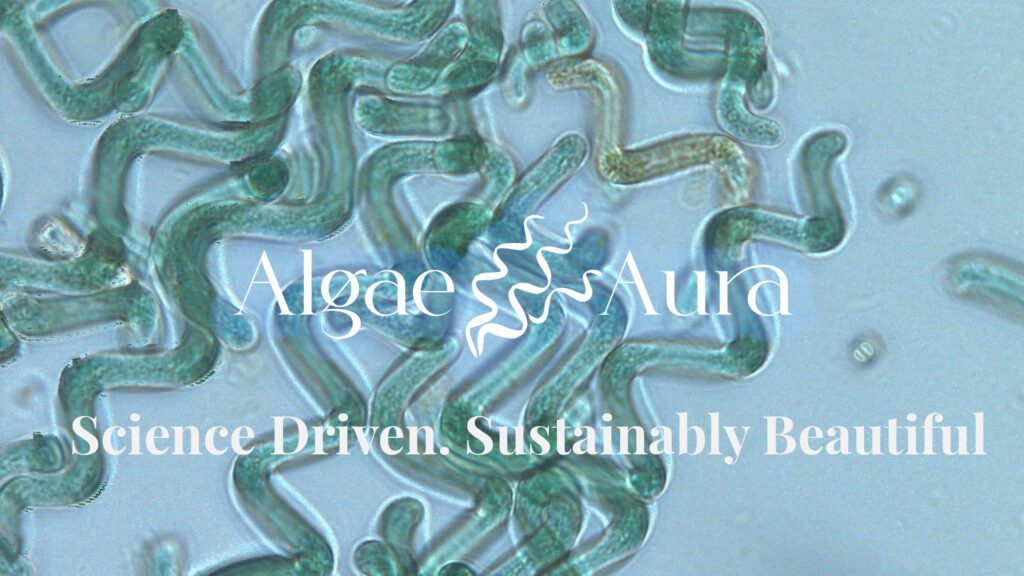
With so many options in the “blue beauty” realm, why should one gravitate towards phycocyanin-infused products, specifically those from Algae Aura? Here are a few compelling reasons:
Sustainability & Traceability: Algae Aura is deeply committed to sustainable beauty. We cultivate our own spirulina in-house, rather than sourcing it from external suppliers. By growing spirulina in controlled, purified water conditions, we ensure that no marine ecosystems are disturbed (unlike wild-harvested seaweeds) and that the quality is consistent. This farm-to-lab approach means we know exactly where our key ingredient comes from and how it’s produced. The spirulina is harvested at peak phycocyanin content and immediately processed, preserving its nutrients. Such traceability is rare – many brands simply buy powdered extracts with unknown histories. At Algae Aura, from the algae’s growth medium to the final bottle, every step is transparent and ethically managed algaeaura.com.
Plus, spirulina cultivation is incredibly eco-friendly: our facilities use solar-powered production methods and recycle water in a closed loop system algaeaura.com. The result is an algae-derived product that you can feel good about using, knowing it didn’t come at the expense of the planet. Purity & Potency through Innovation: By handling extraction and formulation ourselves, Algae Aura achieves a level of purity that sets our phycocyanin apart. We isolate phycocyanin without chemical solvents and without diluting it with fillers. This means our serums and creams deliver a high concentration of active phycocyanin for maximum efficacy. Many competitors include a token amount of “spirulina extract” just to tint a product blue, but at Algae Aura we include phycocyanin at scientifically substantiated levels. Our innovation lies in stabilizing this blue protein so it remains active in the final product – a result of extensive R&D and our team’s expertise in algae science. In short, you’re getting a truly potent dose of the algae’s benefits, not just a marketing sprinkle. This potency translates to visible results: smoother, calmer, more resilient skin.
Scientific Integrity & Transparency: Algae Aura prides itself on being science-driven. We don’t make claims lightly – every benefit we advertise for our products is backed by research, whether it’s published literature or our own laboratory and clinical testing. In an industry where “natural” products sometimes rely on myth more than fact, we strive to be an exception. Our philosophy of “no empty claims” is ingrained in everything we do algaeaura.com. We openly share the rationale behind our formulas, educate consumers on how phycocyanin works, and even publish insights on algae science on our blog. This commitment to truth in labeling and education means that when you choose Algae Aura, you’re not just buying a blue cream – you’re investing in a product rooted in real evidence and crafted by people who genuinely understand their ingredient at a molecular level. We think customers deserve that honesty and expertise, especially in clean beauty.
Eco-Conscious Luxury: With Algae Aura, you don’t have to choose between indulgence and responsibility. Our products feel luxurious – silky textures, elegant packaging, sensorial application – yet they are created with a clear eco-conscience. We utilize zero-waste formulations and sustainable packaging where possible, and even our spirulina farming process helps reduce carbon footprint (algae are carbon sinks by nature!) algaeaura.com. So you’re treating your skin and treating the earth kindly at the same time. This is a core part of our brand ethos: to elevate natural skincare with innovations that are as gentle on the environment as they are on your skin.
In summary, phycocyanin-based skincare, especially as formulated by Algae Aura, offers a rare intersection of efficacy, safety, and sustainability. You get a high-performance ingredient that dermatologists and scientists respect, delivered in a pure and conscious way. It’s blue beauty at its best – where cutting-edge science meets the wisdom of nature.
Conclusion
The rise of blue-hued skincare is more than just a visual trend – it’s rooted in real benefits, and phycocyanin exemplifies how much science there is in this art of “blue beauty.” From protecting against aging accelerators to soothing irritation and enhancing skin vitality, phycocyanin brings a powerhouse of properties to modern skincare formulations. Its algae origin makes it an eco-friendly champion, and its extensive research pedigree sets it apart from many plant extracts. By incorporating phycocyanin, brands like Algae Aura are able to elevate natural skincare to new levels of performance, bridging the gap between clean ingredients and clinical results.
If you’re curious to experience the difference for yourself, we invite you to explore Algae Aura’s phycocyanin-powered products – your skin will drink up the “blue” goodness. Check out our online shop to learn more about our signature EnviroShield serum and other offerings enriched with freshly harvested algae extracts. We’re confident that once you see the calming, revitalizing effect this rare blue antioxidant can have on your complexion, you’ll understand why we’re so passionate about the science of blue.
Join the conversation: Have you tried any blue-infused skincare ingredients, or is phycocyanin new to your radar? We’d love to hear your thoughts, questions, or personal experiences with these natural blue wonders. Feel free to share in the comments – let’s explore the future of clean, algae-powered beauty together!
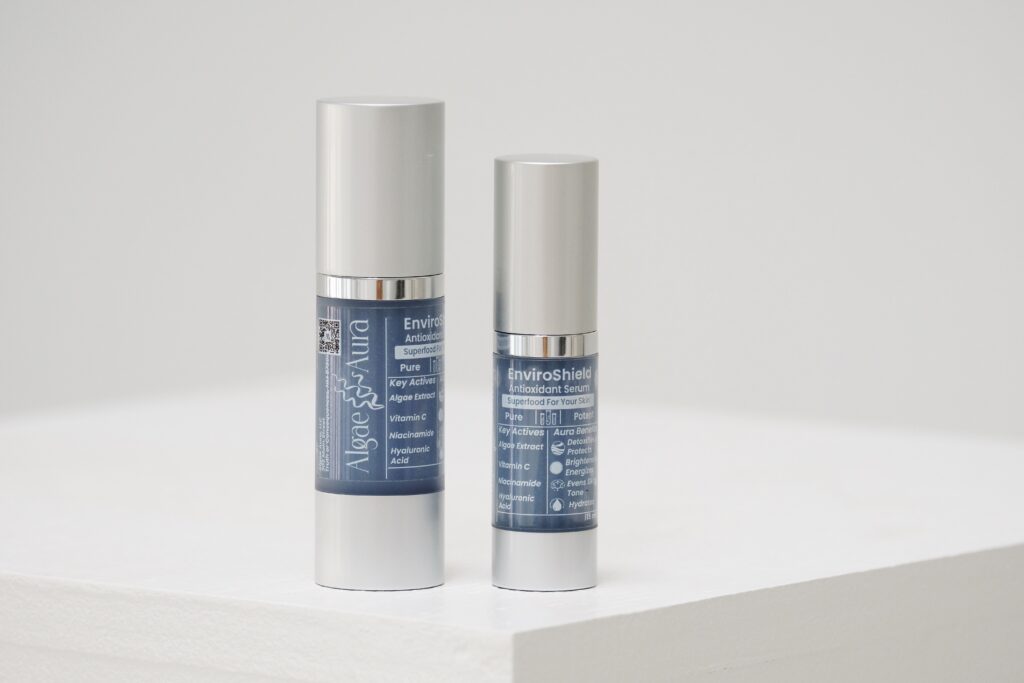
Sources:
- Ragusa, I. et al. Spirulina for Skin Care: A Bright Blue Future. Cosmetics 8, 7 (2021). Phycocyanin is a water-soluble, non-toxic blue pigment from Spirulina, extensively researched for its antioxidation and anti-inflammatory activities
.
- Vitacost Blog. Now Trending in Beauty: Discover the Magic of Blue Tansy Oil (2018). Blue tansy’s vibrant hue and soothing benefits have made it a “hot new beauty trend,” captivating the health and beauty world “by gorgeous, blue storm”
. Derived from a North African flower, it’s known for calming, soothing, and anti-inflammatory properties
.
- 40 Aprons. All About Blue Tansy (2021). Blue tansy (Tanacetum annuum), nicknamed Moroccan chamomile, owes its vivid blue color to chamazulene formed during distillation
. It is prized for its antioxidant and anti-inflammatory properties, commonly used to calm irritated or acne-prone skin
.
- Dermatology M. Indigo – A Chinese Super-Herb. Indigo Naturalis (Qing Dai) has been revered in Chinese medicine for centuries for treating inflammatory skin conditions. It contains indirubin and tryptanthrin that curb excessive skin cell turnover and inflammation, excellent for psoriasis and eczema
. Modern studies confirm indigo’s efficacy: a clinical trial showed Indigo naturalis ointment significantly improved atopic dermatitis (eczema) symptoms safely
.
- SantaFe.com. Health and Beauty Benefits of the Butterfly Pea Flower. Butterfly pea flower (Clitoria ternatea) is rich in anthocyanin antioxidants. Studies show it can increase skin hydration, slow skin aging, and help treat skin irritation, redness, and allergies
.
- ResearchGate (Pham-Huy et al.). Phycocyanin is an Antioxidant Protector of Human Erythrocytes (2001). C-Phycocyanin demonstrated remarkable antioxidant potency, measured to be ~16 times greater than vitamin E (Trolox) and ~20 times greater than vitamin C
, highlighting its superior free-radical scavenging ability.
- Bhatt, A.N. et al. C-Phycocyanin – In vivo toxicity, antioxidant and immunomodulatory studies (2021)
. In vivo experiments in mice showed C-phycocyanin is very safe (no toxicity) and has substantial antioxidant and anti-inflammatory activity, supporting its use as a health-promoting compound.
- Callaghan, T. The Blue Economy: Algae and Seaweeds are Transforming Skincare (2025) – Covalo Blog. Discusses how fast-growing algae offer sustainable, high-performance ingredients for beauty. Algae require minimal resources and have advantages over higher plants in producing bioactive metabolites
. The luxury market is embracing phycocyanin-rich blue extracts from Spirulina for their skin benefits
.
- bareLUXE Skincare. Blue Tansy Oil: Skincare Saviour or Stinky Ingredient? Blue tansy essential oil is potent and must be diluted; at full strength it can stain skin and cause sensitization. Like all essential oils, it may irritate some individuals, so proper patch-testing is important
. The Tanacetum annuum plant is rare and not easy to harvest, raising sustainability concerns and risk of adulteration due to high demand
.
- La Mer – Our Craft. La Mer’s iconic Crème de la Mer uses a fermented giant sea kelp extract. Giant kelp (Macrocystis pyrifera) grows up to 2–3 feet per day and is rich in nutrients; its self-regenerating properties made it ideal for La Mer’s cell-renewing Miracle Broth
. The kelp is sustainably hand-harvested at peak times to ensure nutrient-rich extracts
, illustrating algae’s role in luxury anti-aging skincare.
- Wikipedia – Alguronic Acid. Alguronic acid is a tradename for a mixture of polysaccharides from microalgae (discovered by Solazyme). Introduced in Algenist’s anti-aging skincare in 2011, it’s claimed to protect algae cells and showed significant improvements in skin anti-aging parameters in lab testing
. This algae-derived compound exemplifies a successful translation of marine biotechnology into a high-value skincare ingredient.
- Algae Aura – Home Page
. (Company information) Algae Aura grows its own Spirulina to ensure peak purity, potency, and eco-friendly sourcing. Production is solar-powered and zero-waste, reflecting a commitment to sustainability. The brand emphasizes evidence-based formulations with no empty claims, providing transparency and scientific integrity in its algae-powered skincare line.

